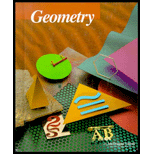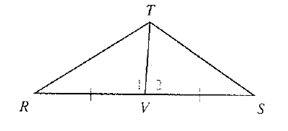
McDougal Littell Jurgensen Geometry: Student Edition Geometry
5th Edition
ISBN: 9780395977279
Author: Ray C. Jurgensen, Richard G. Brown, John W. Jurgensen
Publisher: Houghton Mifflin Company College Division
expand_more
expand_more
format_list_bulleted
Concept explainers
Question
Chapter 6.5, Problem 3CE
To determine
To name: the theorem that supports the deduction.
Expert Solution & Answer
Answer to Problem 3CE
Side-
Explanation of Solution
Given information:
Given figure,

Calculation:
Consider the following data:
And,
Also
Then applying side-angle-side inequality,
Therefore, it is concluded that,
Chapter 6 Solutions
McDougal Littell Jurgensen Geometry: Student Edition Geometry
Ch. 6.1 - Prob. 1CECh. 6.1 - Prob. 2CECh. 6.1 - Prob. 3CECh. 6.1 - Prob. 4CECh. 6.1 - Prob. 5CECh. 6.1 - Prob. 6CECh. 6.1 - Prob. 7CECh. 6.1 - Prob. 8CECh. 6.1 - Prob. 9CECh. 6.1 - Prob. 10CE
Ch. 6.1 - Prob. 11CECh. 6.1 - Prob. 12CECh. 6.1 - Prob. 13CECh. 6.1 - Prob. 14CECh. 6.1 - Prob. 15CECh. 6.1 - Prob. 16CECh. 6.1 - Prob. 17CECh. 6.1 - Prob. 18CECh. 6.1 - Prob. 19CECh. 6.1 - Prob. 20CECh. 6.1 - Prob. 1WECh. 6.1 - Prob. 2WECh. 6.1 - Prob. 3WECh. 6.1 - Prob. 4WECh. 6.1 - Prob. 5WECh. 6.1 - Prob. 6WECh. 6.1 - Prob. 7WECh. 6.1 - Prob. 8WECh. 6.1 - Prob. 9WECh. 6.1 - Prob. 10WECh. 6.1 - Prob. 11WECh. 6.1 - Prob. 12WECh. 6.1 - Prob. 13WECh. 6.2 - Prob. 1CECh. 6.2 - Prob. 2CECh. 6.2 - Prob. 3CECh. 6.2 - Prob. 4CECh. 6.2 - Prob. 5CECh. 6.2 - Prob. 6CECh. 6.2 - Prob. 7CECh. 6.2 - Prob. 8CECh. 6.2 - Prob. 9CECh. 6.2 - Prob. 10CECh. 6.2 - Prob. 11CECh. 6.2 - Prob. 12CECh. 6.2 - Prob. 1WECh. 6.2 - Prob. 2WECh. 6.2 - Prob. 3WECh. 6.2 - Prob. 4WECh. 6.2 - Prob. 5WECh. 6.2 - Prob. 6WECh. 6.2 - Prob. 7WECh. 6.2 - Prob. 8WECh. 6.2 - Prob. 9WECh. 6.2 - Prob. 10WECh. 6.2 - Prob. 11WECh. 6.2 - Prob. 12WECh. 6.2 - Prob. 13WECh. 6.2 - Prob. 14WECh. 6.2 - Prob. 15WECh. 6.2 - Prob. 16WECh. 6.2 - Prob. 17WECh. 6.2 - Prob. 18WECh. 6.2 - Prob. 19WECh. 6.2 - Prob. 20WECh. 6.2 - Prob. 21WECh. 6.2 - Prob. 22WECh. 6.2 - Prob. 1MRECh. 6.2 - Prob. 2MRECh. 6.2 - Prob. 3MRECh. 6.2 - Prob. 4MRECh. 6.2 - Prob. 5MRECh. 6.2 - Prob. 6MRECh. 6.2 - Prob. 7MRECh. 6.2 - Prob. 8MRECh. 6.2 - Prob. 9MRECh. 6.3 - Prob. 1CECh. 6.3 - Prob. 2CECh. 6.3 - Prob. 3CECh. 6.3 - Prob. 4CECh. 6.3 - Prob. 5CECh. 6.3 - Prob. 6CECh. 6.3 - Prob. 7CECh. 6.3 - Prob. 8CECh. 6.3 - Prob. 9CECh. 6.3 - Prob. 10CECh. 6.3 - Prob. 1WECh. 6.3 - Prob. 2WECh. 6.3 - Prob. 3WECh. 6.3 - Prob. 4WECh. 6.3 - Prob. 5WECh. 6.3 - Prob. 6WECh. 6.3 - Prob. 7WECh. 6.3 - Prob. 8WECh. 6.3 - Prob. 9WECh. 6.3 - Prob. 10WECh. 6.3 - Prob. 11WECh. 6.3 - Prob. 12WECh. 6.3 - Prob. 13WECh. 6.3 - Prob. 14WECh. 6.3 - Prob. 15WECh. 6.3 - Prob. 16WECh. 6.3 - Prob. 17WECh. 6.3 - Prob. 18WECh. 6.3 - Prob. 19WECh. 6.3 - Prob. 20WECh. 6.3 - Prob. 1ST1Ch. 6.3 - Prob. 2ST1Ch. 6.3 - Prob. 3ST1Ch. 6.3 - Prob. 4ST1Ch. 6.3 - Prob. 5ST1Ch. 6.3 - Prob. 6ST1Ch. 6.3 - Prob. 7ST1Ch. 6.3 - Prob. 8ST1Ch. 6.3 - Prob. 9ST1Ch. 6.3 - Prob. 10ST1Ch. 6.4 - Prob. 1CECh. 6.4 - Prob. 2CECh. 6.4 - Prob. 3CECh. 6.4 - Prob. 4CECh. 6.4 - Prob. 5CECh. 6.4 - Prob. 6CECh. 6.4 - Prob. 7CECh. 6.4 - Prob. 8CECh. 6.4 - Prob. 9CECh. 6.4 - Prob. 10CECh. 6.4 - Prob. 11CECh. 6.4 - Prob. 12CECh. 6.4 - Prob. 13CECh. 6.4 - Prob. 14CECh. 6.4 - Prob. 15CECh. 6.4 - Prob. 16CECh. 6.4 - Prob. 17CECh. 6.4 - Prob. 18CECh. 6.4 - Prob. 19CECh. 6.4 - Prob. 20CECh. 6.4 - Prob. 1WECh. 6.4 - Prob. 2WECh. 6.4 - Prob. 3WECh. 6.4 - Prob. 4WECh. 6.4 - Prob. 5WECh. 6.4 - Prob. 6WECh. 6.4 - Prob. 7WECh. 6.4 - Prob. 8WECh. 6.4 - Prob. 9WECh. 6.4 - Prob. 10WECh. 6.4 - Prob. 11WECh. 6.4 - Prob. 12WECh. 6.4 - Prob. 13WECh. 6.4 - Prob. 14WECh. 6.4 - Prob. 15WECh. 6.4 - Prob. 16WECh. 6.4 - Prob. 17WECh. 6.4 - Prob. 18WECh. 6.4 - Prob. 19WECh. 6.4 - Prob. 20WECh. 6.4 - Prob. 21WECh. 6.4 - Prob. 22WECh. 6.4 - Prob. 23WECh. 6.4 - Prob. 24WECh. 6.4 - Prob. 1AECh. 6.4 - Prob. 2AECh. 6.4 - Prob. 1BECh. 6.4 - Prob. 2BECh. 6.4 - Prob. 3BECh. 6.5 - Prob. 1CECh. 6.5 - Prob. 2CECh. 6.5 - Prob. 3CECh. 6.5 - Prob. 4CECh. 6.5 - Prob. 5CECh. 6.5 - Prob. 6CECh. 6.5 - Prob. 7CECh. 6.5 - Prob. 8CECh. 6.5 - Prob. 9CECh. 6.5 - Prob. 10CECh. 6.5 - Prob. 1WECh. 6.5 - Prob. 2WECh. 6.5 - Prob. 3WECh. 6.5 - Prob. 4WECh. 6.5 - Prob. 5WECh. 6.5 - Prob. 6WECh. 6.5 - Prob. 7WECh. 6.5 - Prob. 8WECh. 6.5 - Prob. 9WECh. 6.5 - Prob. 10WECh. 6.5 - Prob. 11WECh. 6.5 - Prob. 12WECh. 6.5 - Prob. 13WECh. 6.5 - Prob. 14WECh. 6.5 - Prob. 15WECh. 6.5 - Prob. 1ST2Ch. 6.5 - Prob. 2ST2Ch. 6.5 - Prob. 3ST2Ch. 6.5 - Prob. 4ST2Ch. 6.5 - Prob. 5ST2Ch. 6.5 - Prob. 6ST2Ch. 6.5 - Prob. 7ST2Ch. 6.5 - Prob. 8ST2Ch. 6.5 - Prob. 9ST2Ch. 6 - Prob. 1CRCh. 6 - Prob. 2CRCh. 6 - Prob. 3CRCh. 6 - Prob. 4CRCh. 6 - Prob. 5CRCh. 6 - Prob. 6CRCh. 6 - Prob. 7CRCh. 6 - Prob. 8CRCh. 6 - Prob. 9CRCh. 6 - Prob. 10CRCh. 6 - Prob. 11CRCh. 6 - Prob. 12CRCh. 6 - Prob. 13CRCh. 6 - Prob. 14CRCh. 6 - Prob. 15CRCh. 6 - Prob. 16CRCh. 6 - Prob. 17CRCh. 6 - Prob. 18CRCh. 6 - Prob. 1CTCh. 6 - Prob. 2CTCh. 6 - Prob. 3CTCh. 6 - Prob. 4CTCh. 6 - Prob. 5CTCh. 6 - Prob. 6CTCh. 6 - Prob. 7CTCh. 6 - Prob. 8CTCh. 6 - Prob. 9CTCh. 6 - Prob. 10CTCh. 6 - Prob. 11CTCh. 6 - Prob. 12CTCh. 6 - Prob. 13CTCh. 6 - Prob. 14CTCh. 6 - Prob. 15CTCh. 6 - Prob. 16CTCh. 6 - Prob. 1ARCh. 6 - Prob. 2ARCh. 6 - Prob. 3ARCh. 6 - Prob. 4ARCh. 6 - Prob. 5ARCh. 6 - Prob. 6ARCh. 6 - Prob. 7ARCh. 6 - Prob. 8ARCh. 6 - Prob. 9ARCh. 6 - Prob. 10ARCh. 6 - Prob. 11ARCh. 6 - Prob. 12ARCh. 6 - Prob. 13ARCh. 6 - Prob. 14ARCh. 6 - Prob. 15ARCh. 6 - Prob. 16ARCh. 6 - Prob. 17ARCh. 6 - Prob. 18ARCh. 6 - Prob. 19ARCh. 6 - Prob. 1CURCh. 6 - Prob. 2CURCh. 6 - Prob. 3CURCh. 6 - Prob. 4CURCh. 6 - Prob. 5CURCh. 6 - Prob. 6CURCh. 6 - Prob. 7CURCh. 6 - Prob. 8CURCh. 6 - Prob. 9CURCh. 6 - Prob. 10CURCh. 6 - Prob. 11CUR
Additional Math Textbook Solutions
Find more solutions based on key concepts
Use any method to evaluate the integrals in Exercises 15–38. Most will require trigonometric substitutions, but...
University Calculus: Early Transcendentals (4th Edition)
If you multiply an odd number by 2 and add 1, is your answer even or odd?
A Problem Solving Approach To Mathematics For Elementary School Teachers (13th Edition)
The equivalent expression of x(y+z) by using the commutative property.
Calculus for Business, Economics, Life Sciences, and Social Sciences (14th Edition)
Hypothesis Testing Using a P-Value In Exercises 31–36,
identify the claim and state H0 and Ha.
find the standar...
Elementary Statistics: Picturing the World (7th Edition)
Force on dams The following figures show the shape and dimensions of small dams. Assuming the water level is at...
Calculus: Early Transcendentals (2nd Edition)
Knowledge Booster
Learn more about
Need a deep-dive on the concept behind this application? Look no further. Learn more about this topic, geometry and related others by exploring similar questions and additional content below.Similar questions
- Find mSWarrow_forwardSelect all solids for which the formula V = Bh applies. A. a triangular prism B. a triangular pyramid C. a square pyramid D. a rectangular prism E. a cone F. a cylinderarrow_forwardThis is my h/w ,Required to find the region of shaded sector ,I don't really know how to deal with this tasks ,so if someone could help me to understand them it would be awesome,and sorry for my poor Englisharrow_forward
- △DEF△DEF has vertices D(0, 2) and F(6, 2). If △DEF△DEF has an area of 12 square units, select all the possible coordinates for E.arrow_forwardIn quadrilateral QRST, m<R=60, m<T=90, QR=RS, ST=8, TQ=8 How long is the longer diagonal of QRST? Find the ratio of RT to QS.arrow_forward13:26 ... ← Robert F. Blitzer - Thinkin... 0,04 61 KB/d 目 polygons to create a fraudulent tessellation with discrepancies that are too subtle for the eye to notice. In Exercises 45-46, you will use mathematics, not your eyes, to observe the irregularities. B A 45. Find the sum of the angle measures at vertex A. Then explain why the tessellation is a fake. 46. Find the sum of the angle measures at vertex B. Then explain why the tessellation is a fake. =et at If se Fic SECTION 10.3 Polygons, Perimeter, and Tessellations 645 61. I find it helpful to think of a polygon's perimeter as the length of its boundary. 62. If a polygon is not regular, I can determine the sum of the measures of its angles, but not the measure of any one of its angles. 63. I used floor tiles in the shape of regular pentagons to completely cover my kitchen floor. In Exercises 64-65, write an algebraic expression that represents the perimeter of the figure shown. is be 64. le a b C 2/ If se nyarrow_forward
- Schoology → C Cportsk12.com bookmarks Sis Grades and Attendance Al Detector - the Original Al Che X GPTZero + portsmouth.schoology.com/common-assessment-delivery/start/7747152192?action=onresume&submissionId=1600790102 New Tab Home | Schoology Quadrilateral Quiz English If WXYZ is a square, and WY = 32, find XY. Round your answer to the nearest tenth. Z XY = R X Y POSSIBLE POINTS: 5 2 of 20 48 21 1 2 345678910 Next ▸ Δ ㄖㄨ All Bookmarks Schoology Help Center | PRIVACY POLICY | Terms of Use PowerSchool ©2025arrow_forwardom nearest tenth if necessary. milsum 3. છે. 9.3mm 3mm A 78-43-92 4-3) 11.7 of 72.04-11.7-= lygons 7.8 mi 60.94 blants" 9 om 6. 4.15-7 16- 32m 1.8m 4.5m % ose 4.5m as to 65m 14 represents 5 square meters.arrow_forwardThe diagonals of rhombus ABCD intersect at E. Given that BAC=53 degrees, DE=8, and EC=6 find AEarrow_forward
- Volume of Dubai Cayan Towerarrow_forward1 B-P P+1+ 2-p 4-p min(Red)=? y=x² A (P,P')arrow_forwardMI P X /courses/segura10706/products/171960/pages/611?locale=&platformId=1030&lms=Y ☆ Finish Part I: Mathematics for Elementary and Middle School Teachers Continue in the app JJ 576 Chapter 12. Area of Shapes 9. Determine the area of the shaded shapes in Figure 12.48. Explain your reasoning. 1 unit S Figure 12.48 1 unit unit and the yarn for thearrow_forward
arrow_back_ios
SEE MORE QUESTIONS
arrow_forward_ios
Recommended textbooks for you
 Elementary Geometry For College Students, 7eGeometryISBN:9781337614085Author:Alexander, Daniel C.; Koeberlein, Geralyn M.Publisher:Cengage,
Elementary Geometry For College Students, 7eGeometryISBN:9781337614085Author:Alexander, Daniel C.; Koeberlein, Geralyn M.Publisher:Cengage, Elementary Geometry for College StudentsGeometryISBN:9781285195698Author:Daniel C. Alexander, Geralyn M. KoeberleinPublisher:Cengage Learning
Elementary Geometry for College StudentsGeometryISBN:9781285195698Author:Daniel C. Alexander, Geralyn M. KoeberleinPublisher:Cengage Learning

Elementary Geometry For College Students, 7e
Geometry
ISBN:9781337614085
Author:Alexander, Daniel C.; Koeberlein, Geralyn M.
Publisher:Cengage,

Elementary Geometry for College Students
Geometry
ISBN:9781285195698
Author:Daniel C. Alexander, Geralyn M. Koeberlein
Publisher:Cengage Learning
Sequences and Series Introduction; Author: Mario's Math Tutoring;https://www.youtube.com/watch?v=m5Yn4BdpOV0;License: Standard YouTube License, CC-BY
Introduction to sequences; Author: Dr. Trefor Bazett;https://www.youtube.com/watch?v=VG9ft4_dK24;License: Standard YouTube License, CC-BY